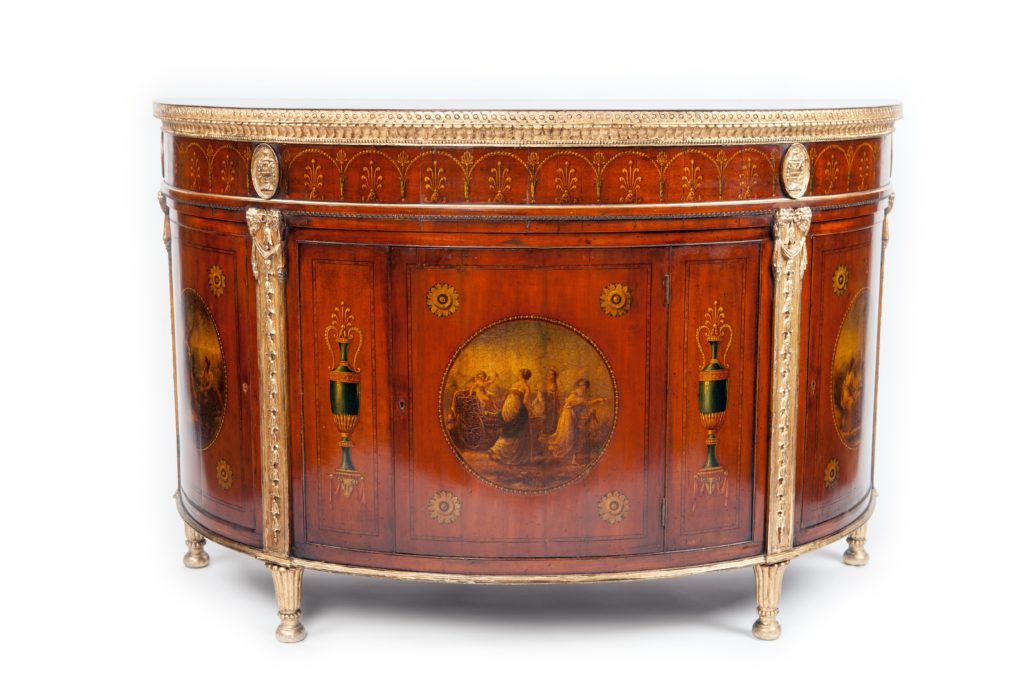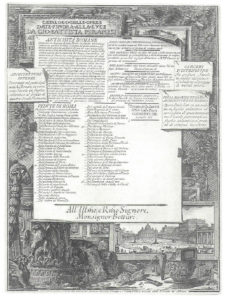
Piranesi’s 1761 Antichita Romane
The death of James Rannie in 1766 came on the cusp of arguably the most productive time for the firm of Chippendale & Rannie, with the association with Robert Adam ramping up and commissions including the enormous job at Harewood in the offing.
It is interesting to consider the nature of the relationship between Adam and Chippendale, with Adam imbued with an appreciation of classical antiquity derived from his grand tour and intimate association with Giovanni Batista Piranesi.
Robert Adam’s grand tour and in particular his time in Rome and the adjacent campagna wrought a sea change from his earlier work, including Dumfries House, and he proved an adept student of Piranesi, introducing design elements with archeological accuracy. These then too were adopted by Chippendale, with neoclassicism displacing the relatively short-lived phenomenon of the rococo as what, between the 1740’s to the 1760’s, was counted as ‘modern taste’.
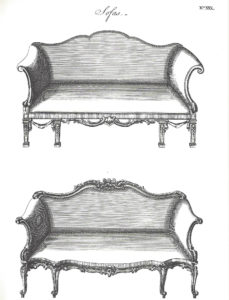
Plate XXX from 1762 edition of Director– neoclassical above, and rococo below
Well- sort of displaced. One looks at the 1762 edition of The Gentleman & Cabinet-Maker’s Director and finds very many plates from the two earlier editions, and based on this evidence, it appears that at least at the time of issuance, the rococo was alive and well. One does though find an increasing number of swags and festoons drawn from classical motifs amongst the rocaille, ‘Gothick’, and Chinoiserie. Of course, it would be simplistic to assume that, like any other design innovation, the popularity of neoclassicism was not gradual in its ascent. It is worth noting that, in Chippendale and Rannie’s first great commission, that of Dumfries House in 1759, what was supplied was entirely in the rococo manner of the 1754 edition of the Director and just a short 3 years before the emergent neoclassicism of the 1762 edition.
I’ve already noted that the furniture inside Dumfries House is a bit at odds with the overall design of the house, an uneasy mixture of Burlingtonian Palladianism and the restrained rococo of the interior plasterwork, and one must assume that the Adam brothers had not much to do with fitting out the house.
This was all to change, of course, following the return of Robert Adam from his grand tour, for it was not just the antiquarianism of Piranesi, but three years of constant tutelage by Charles-Louis Clerisseau as drawing master and bear-leader that gave Adam a style and manner of architectural output that served and informed his prodigious output for the next 30 years.
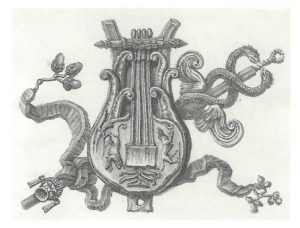
Lyre and caduceus from Piranesi’s il Camp Marzio dell’Antica Roma, circa 1750
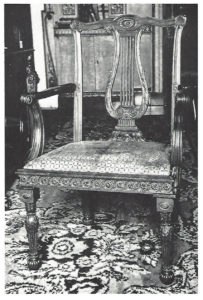
Lyre-back chair by Thos Chippendale, Nostell Priory, to an Adam design
This year is Chippendale’s tercentenary, and the naturally tendentious focus is on his design and output, but the importance of the overarching influence of Robert Adam, and by extension that of Clerisseau and particularly Piranesi might be, but should never be, overlooked. While much has been made of Chippendale’s skill and draughtsmanship in furniture design, very little output, save the Dumfries House commission, follows his patterns. Very much more was executed by Chippendale’s workshop- but to the designs of Robert Adam. The lyre back library chair from Nostell Priory is illustrated by both the late Christopher Gilbert and Adam Bowett as an example of Chippendale’s work in a neoclassical idiom, but it is also illustrated in Eileen Harris’ The Furniture of Robert Adam. That it is more firmly in Adam’s oeuvre than perhaps that of Thomas Chippendale is given weight by an examination of the design inspiration. An engraving of a lyre and caduceus in Piranesi’s Il Campo Marzo dell ’Antica Roma links not just with the splat of chairs executed by Chippendale for Nostell Priory, but also to a similar chair executed by John Linnell for Osterley Park- both major Adam commissions.
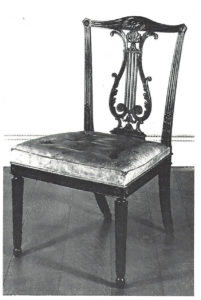
Lyre-back chair at Osterley Park, by John Linnell to an Adam design
Something that Christopher Gilbert accepted as a given is the mastery of draughtsmanship Chippendale possessed, and was particularly complimentary of how they were transferred to print in the 1754 edition of the Director when engraved by Matthias Darly. The uniformly good quality is very much marred, in his view, in subsequent editions by engravings of variable quality. It might just be that, particularly in the case of the 1762 edition of the Director, not just the engravings but the drawings from which they are derived have a hodgepodge effect, reflecting as they do not just innovative designs but those that were popular with the workshop’s customers, without regard to current fashion.
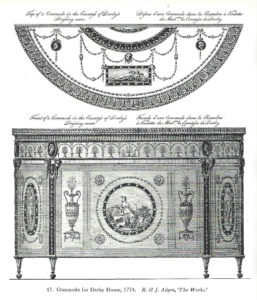
Robert Adam, design for demilune commode for Lady Derby, circa 1774, as illustrated in Eileen Harris, The Furniture of Robert Adam
The discordance between design and movables noted at Dumfries House is something of a general occurrence. Eileen Harris in writing about Adam designed furniture puts this down to the typical brief of the architect- designing exterior elevations and those of some interior walls- while the furnishing of the interior footprint was left to the client. She points out that the preponderance of furniture designed by Adam were the likes of pier mirrors and pier tables. Given their placement adjacent to and concordant with interior walls and architectural elements, these types of pieces then have an inherent character that puts them more in the brief of the architect.
With all that, the cabinetmaker that was to furnish more Adam domestic interiors than anyone else was Thomas Chippendale. This does not mean that Adam and Chippendale had what could be termed a relationship of collegial exclusivity, as a number of Adam interiors exist furnished by other workshops. Arguably one of the best Adam interiors, the Etruscan room at Osterley Park, was completed by John Linnell. It has even been suggested that Robert Adam was not a hearty proponent of Chippendale, owing to the workshop’s slow completion of commissions. It might be, as well, that between the architect and designer there was a stylistic divergence that perhaps made each wary of the other. The abundance of surface decoration in furniture to an Adam design, wrought in at times composition material applied to vernacular woods, and then elaborately painted to appear of a piece with wall and plaster treatments was certainly at odds with the preference the Chippendale workshop had for carved details wrought in exotic woods. Indeed, even the marquetry furniture at Harewood, frequently regarded as the most masterful of the suites created by the Chippendale workshop, though of a neoclassical and not rococo style, are at odds with the interiors created by Adam.
I don’t think anyone would argue that in his day, Adam was much, much more a style setter than was Thomas Chippendale. Adam, though, had very shortly after his death detractors who found much more if not originality than authenticity in what became the Greek revival movement in the very late 18th and early 19th centuries, and the stripped-down neoclassicism of Sir John Soane. So much was written at that time of Adam’s work, particularly his late work, as thin and delicately attenuated, with his passion for movement in surface decoration characterized by one early Victorian pundit as ‘frippery’.

